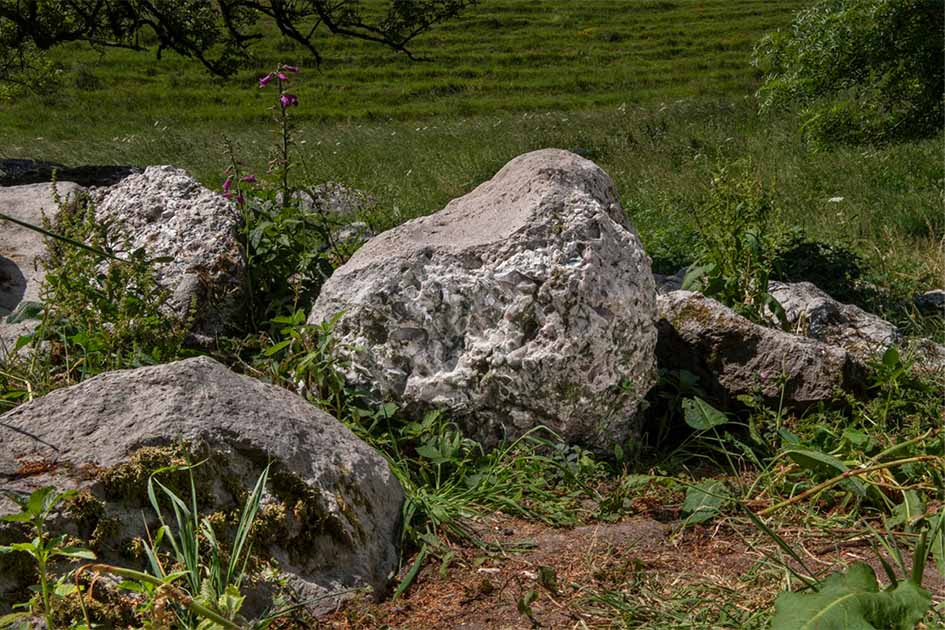By Sahir Pandey

Dr. Hayley Roberts, Jim Rylatt and Dr. Anne Teather from Past Participate found the polishing stone at the Valley of Stones in Dorset.
A “vanishingly rare” polishing stone called a polissoir has been uncovered by a team of volunteers in the Valley of Stones national nature reserve in Dorset, England. This extraordinary 5,000-year-old find was once used to sharpen tools and weapons like axes.
This is only the second ever instance of an “earthfast” polissoir found in England, meaning that it was firmly embedded in its original position! The ancient polishing stone was initially mistaken for an ordinary rugged boulder amidst a cluster of others, but the stone's distinctive smooth and glossy dip betrayed its exceptional nature.

The polishing stone, or polissoir, has a distinctive glossy dip where stone axe heads were once polished 5,000 years ago.
Polishing Stones: Important Tools Employed by Our Early Ancestors
Polissoirs, also known as polishing stones, were crucial tools employed by Neolithic Stone Age communities to perfect the sharpness and effectiveness of their axes. The term polissoir is derived from the French word for “polisher,” reflecting the fact that a large number of these artifacts have been found in France.
It is believed that the polissoir in question was situated near a historic thoroughfare, suggesting it may have served as a destination for axe polishing and stone head axe making rather than a settlement site, reported The Guardian .
Polissoirs are typically elongated stones with a smooth and polished surface, often displaying distinctive wear patterns. They were crafted to provide a suitable surface for honing and polishing stone tools, enhancing their cutting edges and overall efficiency. Neolithic people would rub the tool against the polissoir's surface in a back-and-forth motion, gradually refining its shape and sharpness.
The unearthing of this precious artifact occurred as volunteers were diligently clearing vegetation to reveal hidden sarsen stones in the area. Dr. Anne Teather and Jim Rylatt, directors of Past Participate CIC , a non-profit organization focused on local heritage exploration, chanced upon the polissoir while overseeing operations in a different section of the valley. The discovery was made in the designated Area of Outstanding Natural Beauty during a heritage project they were overseeing.
Polishing Stone Discovery Reveals a Stone Age Work Station!
“It’s a relatively unprepossessing boulder on one side,” said Rylatt, who first spotted the the polishing stone by flicking away some leaves and chancing upon the shiny surface. “It’s safe to say I was surprised. The only other one found in situ in England was found in the 1960s at Fyfield Down [in Wiltshire].”
“There are more imposing stones here but this one ticked the boxes for them. They must have spent many hundreds, thousands of hours polishing here,” he said, as he envisaged the work going on at the site over 5,000 years ago.
Teather speculated that the site could have functioned as a workspace rather than a residential area, proposing activities such as animal skin processing and meat preparation. Notably, the polissoir's proximity to an ancient path reinforces the notion that people would congregate at the stone to refine their axes, indicating it was a site of utility and transit.
During the Neolithic era , stone axes played a pivotal role in the lives of early farmers, serving purposes such as clearing woodlands and constructing dwellings or monuments. These axes were crafted using diverse raw materials like flint, volcanic tuff and granite. Evidence suggests that stone axes were widely circulated during prehistoric times, potentially through trade networks or as personal possessions carried from distant quarries.
“The stones would have been extremely important to Neolithic people, as without axes they could not have cleared woodland and farming would have been impossible,” explained Rylatt. What also caught their fancy was that that the boulder was made out of sarsen stone, the same hard form of sandstone material used to make the Stonehenge, reported the BBC

Analysis: What Does the Polishing Stone Discovery Mean?
Following the discovery of the polissoir, meticulous excavations and specialized analyses were conducted in the vicinity to determine if any remnants of the individuals who crafted the stone axes were still present. Polissoirs can either be earthfast or portable, with France being a significant hub for such finds, reported Planet Radio .
The Valley of Stones , with its rich archaeological heritage, continues to dazzle archaeologists and historians alike. The current polissoir is not going to be taken to a museum. Instead it will be left where it was found and the area surrounding it will be excavated and analyzed.
SOURCE 15 JULY, 2023 - 18:49

 www.ancient-origins.net
www.ancient-origins.net
Dr. Hayley Roberts, Jim Rylatt and Dr. Anne Teather from Past Participate found the polishing stone at the Valley of Stones in Dorset.
A “vanishingly rare” polishing stone called a polissoir has been uncovered by a team of volunteers in the Valley of Stones national nature reserve in Dorset, England. This extraordinary 5,000-year-old find was once used to sharpen tools and weapons like axes.
This is only the second ever instance of an “earthfast” polissoir found in England, meaning that it was firmly embedded in its original position! The ancient polishing stone was initially mistaken for an ordinary rugged boulder amidst a cluster of others, but the stone's distinctive smooth and glossy dip betrayed its exceptional nature.
The polishing stone, or polissoir, has a distinctive glossy dip where stone axe heads were once polished 5,000 years ago.
Polishing Stones: Important Tools Employed by Our Early Ancestors
Polissoirs, also known as polishing stones, were crucial tools employed by Neolithic Stone Age communities to perfect the sharpness and effectiveness of their axes. The term polissoir is derived from the French word for “polisher,” reflecting the fact that a large number of these artifacts have been found in France.
It is believed that the polissoir in question was situated near a historic thoroughfare, suggesting it may have served as a destination for axe polishing and stone head axe making rather than a settlement site, reported The Guardian .
Polissoirs are typically elongated stones with a smooth and polished surface, often displaying distinctive wear patterns. They were crafted to provide a suitable surface for honing and polishing stone tools, enhancing their cutting edges and overall efficiency. Neolithic people would rub the tool against the polissoir's surface in a back-and-forth motion, gradually refining its shape and sharpness.
The unearthing of this precious artifact occurred as volunteers were diligently clearing vegetation to reveal hidden sarsen stones in the area. Dr. Anne Teather and Jim Rylatt, directors of Past Participate CIC , a non-profit organization focused on local heritage exploration, chanced upon the polissoir while overseeing operations in a different section of the valley. The discovery was made in the designated Area of Outstanding Natural Beauty during a heritage project they were overseeing.
Polishing Stone Discovery Reveals a Stone Age Work Station!
“It’s a relatively unprepossessing boulder on one side,” said Rylatt, who first spotted the the polishing stone by flicking away some leaves and chancing upon the shiny surface. “It’s safe to say I was surprised. The only other one found in situ in England was found in the 1960s at Fyfield Down [in Wiltshire].”
“There are more imposing stones here but this one ticked the boxes for them. They must have spent many hundreds, thousands of hours polishing here,” he said, as he envisaged the work going on at the site over 5,000 years ago.
Teather speculated that the site could have functioned as a workspace rather than a residential area, proposing activities such as animal skin processing and meat preparation. Notably, the polissoir's proximity to an ancient path reinforces the notion that people would congregate at the stone to refine their axes, indicating it was a site of utility and transit.
During the Neolithic era , stone axes played a pivotal role in the lives of early farmers, serving purposes such as clearing woodlands and constructing dwellings or monuments. These axes were crafted using diverse raw materials like flint, volcanic tuff and granite. Evidence suggests that stone axes were widely circulated during prehistoric times, potentially through trade networks or as personal possessions carried from distant quarries.
“The stones would have been extremely important to Neolithic people, as without axes they could not have cleared woodland and farming would have been impossible,” explained Rylatt. What also caught their fancy was that that the boulder was made out of sarsen stone, the same hard form of sandstone material used to make the Stonehenge, reported the BBC
Stones scatter the earth in the Valley of Stones in Dorset, England.
.Analysis: What Does the Polishing Stone Discovery Mean?
Following the discovery of the polissoir, meticulous excavations and specialized analyses were conducted in the vicinity to determine if any remnants of the individuals who crafted the stone axes were still present. Polissoirs can either be earthfast or portable, with France being a significant hub for such finds, reported Planet Radio .
The Valley of Stones , with its rich archaeological heritage, continues to dazzle archaeologists and historians alike. The current polissoir is not going to be taken to a museum. Instead it will be left where it was found and the area surrounding it will be excavated and analyzed.
SOURCE 15 JULY, 2023 - 18:49

Rare 5,000-Year-Old Axe Polishing Stone Found in England
A “vanishingly rare” polishing stone called a polissoir has been uncovered by a team of volunteers in the Valley of Stones national nature reserve in Dorset, England.
Upvote
10








